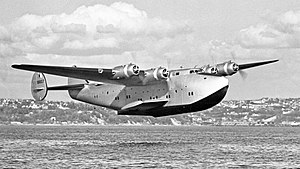The Boeing 314 Clipper was a flying boat. It was made by the Boeing Airplane Company between 1938 and 1941. It was one of the biggest planes at that time, and it used the wing of the XB-15 bomber. Twelve Clippers were made for Pan Am. Three of them were sold to BOAC during the Battle of Britain (1940).
| 314 Clipper | |
|---|---|
 | |
| A Boeing 314 “Clipper” | |
| Role | Flying boat airliner |
| Manufacturer | Boeing Airplane Company |
| First flight | June 7, 1938 |
| Introduction | 1939 |
| Retired | 1946 |
| Status | Retired |
| Primary users | Pan American World Airways British Overseas Airways Corporation United States Navy |
| Produced | 1938–1941 |
| Number built | 12 |
| Developed from | Boeing XB-15 (used wing only) |
Design and development

Pan American had asked for a flying boat with a very long range. Boeing wanted to make it, and Pan American asked for six of Boeing's planes. Boeing engineers used a 149 feet (45 m) wing taken from one of Boeing's earlier planes. The new plane had 1,600 horsepower (1,200 kW) Wright Twin Cyclone.[1]
The plane made flew for the first time on June 7, 1938. The test pilot found some things wrong with the plane. Boeing fixed these and the plane was fine.[2]
Weight was very important. Every passenger could only have 77 pounds (35 kg) of baggage for free. They had to pay $3.25 per lb ($7.15/kg) if they went over this limit.[3]

Pan Am's "Clippers" were meant for luxury. The seats could be changed into beds. The plane normally flew at only 188 miles per hour (303 km/h), so flights sometimes lasted more than 12 hours.[4] The 314s had a lounge and dining area, and the planes had chefs from four-star hotels. Men and women had dressing rooms, too. The luxury on Pan American's Boeing 314s was better than anything since then. They were for very rich people. It cost about the same amount as it would have cost to fly on Concorde in 2006.[5]
The 314 was also successful because of its Pan Am flight crews. They were very good at long-distance flying. Many of the flights had another crew for training.[6] Only the best pilots flew the Boeing 314. If it was hard to see because of fog, pilots sometimes landed at sea and then moved Clipper on the water.[7]
History

The first 314, Honolulu Clipper, started being used in January 1939.
When war started in the Pacific, Pacific Clipper was flying to New Zealand. Instead of going back to Honolulu, it went to New York. This was done to avoid being shot down by Japanese fighters.
Pan Am's Boeing 314s were used by the military in World War II. The only thing that changed was how the painting on the plane looked. The Clippers were still flown by their crews from Pan Am. The Boeing 314s used by the military were called C-98s. Winston Churchill flew on Boeing 314s sometimes.[8]
After the war, many Clippers were given back to Pan Am. However, the Boeing 314 was now out-of-date.
Retirement

One Pan Am 314, called the California Clipper, had flown more than one million miles when it was retired.[9] Three Boeing 314s crashed.[10]
Types of Boeing 314
- Model 314
- First version, six made
- Model 314A
- Better version with better engines, more fuel and better cabin. It would fly for 4,700 miles.[11] Six were made.
Users
Boeing 314s which still exist
No Boeing 314s still exist today. However, there is a replica at the Foynes Flying Boat Museum, Foynes, County Limerick, Ireland.[12]
Details (314A Clipper)

Data from Jane's Fighting Aircraft of World War II[13]
General characteristics
- Crew: 11, including 2 cabin stewards
- Capacity: Daytime: 74 passengers, Nighttime: 36 passengers
- Payload: 10,000 lb (4,500 kg) of mail and cargo
- Length: 106 ft (32.33 m)
- Wingspan: 152 ft (46.36 m)
- Height: 20 ft 4½ in (6.22 m)
- Empty weight: 48,400 lb (21,900 kg)
- Loaded weight: 84,000 lb (38,000 kg)
- Powerplant: 4 × Wright R-2600-3 radial engines, 1,600 hp (1,200 kW) each
Performance
- Maximum speed: 210 mph (180 knots, 340 km/h)
- Cruise speed: 188 mph (163 knots, 302 km/h) at 11,000 ft (3,400 m)
- Range: 3,685 mi (3,201 nm, 5,896 km) normal cruise
- Service ceiling: 19,600 ft (5,980 m)
References
Other websites
Wikiwand in your browser!
Seamless Wikipedia browsing. On steroids.
Every time you click a link to Wikipedia, Wiktionary or Wikiquote in your browser's search results, it will show the modern Wikiwand interface.
Wikiwand extension is a five stars, simple, with minimum permission required to keep your browsing private, safe and transparent.
